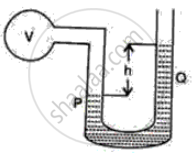Advertisements
Advertisements
Question
A force of 50 kgf is applied to the smaller piston of a hydraulic machine. Neglecting friction, find the force exerted on the large piston, if the diameters of the pistons are 5 cm and 25 cm respectively.
Solution
Ratio of diameter of smaller piston to bigger piston = 5 : 25
∴ Ratio of area of smaller piston to bigger piston = 25 : 625
Force applied on smaller piston , F1 = 50 kgf
Let F2 be the force on the bigger piston .
By the principle of hydraulic machine ,
Pressure on narrow piston = pressure on wider piston
or , `F_1/A_1 = F_2/A_2`
or , `F_1/F_2 = A_1/A_2`
or , `50/F_2 = 25/625`
or , `F_2 = 50 xx 625/25 = 1250` kgf
APPEARS IN
RELATED QUESTIONS
Define one pascal (Pa), the S.I. unit of pressure.
In a hydraulic machine, a force of 2 N is applied on the piston of area of cross section 10 cm2. What force is obtained on its piston of area of cross section 100 cm2 ?
The areas of pistons in a hydraulic machine are 5 cm2 and 625 cm2. What force on the smaller piston will support a load of 1250 N on the larger piston? State any assumption which you make in your calculation.
What force is applied on a piston of area of cross section 2 cm2 to obtain a force 150 N on the piston of area of cross section 12 cm2 in a hydraulic machine?
The following figure shows a manometer containing a liquid of density p. The limb P of the manometer is connected to a vessel V and the limb Q is open to atmosphere. The difference in the levels of liquid in the two limbs of the manometer is h as shown in the diagram. The atmospheric pressure is P0.
(i) What is the pressure on the liquid surface in the limb Q?
(ii) What is the pressure on the liquid surface in the limb P?

What are the factors on which the pressure of a liquid depends?
Do all liquids exert pressure?
Unit of pressure is
